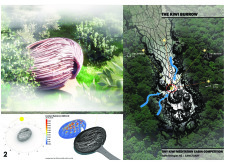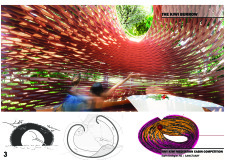5 key facts about this project
The Kiwi Burrow is a meditation cabin designed to fit within its natural surroundings in a glade. The pavilion draws inspiration from a kiwi burrow found in New Zealand's native bush, serving as a quiet place for contemplation. Its design encourages visitors to connect with nature, offering a peaceful environment for meditation and reflection.
Spatial Organization
The layout features a simple and open design, which helps limit distractions and creates a calming atmosphere. Visitors arrive via a timber deck that guides them into a circle of trees, making the transition from the outside landscape to the interior smooth. Inside, a continuous bench wraps around the pavilion, connecting to both a fire pit and an altar. This arrangement supports both individual and communal meditation practices.
Light and Atmosphere
Natural light is an important element in the design. The pavilion is placed to capture sunlight filtering through the forest canopy. Thoughtfully positioned openings allow light to enter the space, creating changing patterns throughout the day. This dynamic use of light enhances the experience inside, adding a warm glow to the altar while tying the inside of the structure to the landscape outside.
Structural Innovation
The building features a self-supporting lattice framework made of corbelled boxes. This unique structure allows for clear spans inside, while also being visually interesting and sensitive to the environment. The lattice is clad in a way that creates openings, helping to limit direct sunlight exposure when it is strongest.
An oculus is included in the roof folds, providing views of the sky. This design detail strengthens the connection between the interior and the natural world outside. It invites visitors to reflect on their surroundings, adding depth to the meditative experience.






















































